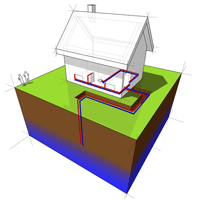 Are you wondering how a geothermal heat pump works? Not surprisingly, more people are catching on and becoming interested in this very efficient form of home heating. Unlike furnaces that burn gas or other natural resources, geothermal heat pumps use natural energy from the sun. Before explaining geothermal, it’s necessary to know how heat pumps work in general.
Are you wondering how a geothermal heat pump works? Not surprisingly, more people are catching on and becoming interested in this very efficient form of home heating. Unlike furnaces that burn gas or other natural resources, geothermal heat pumps use natural energy from the sun. Before explaining geothermal, it’s necessary to know how heat pumps work in general.
How Heat Pumps Work
Heat pumps move heat from the outside to indoors. Normally, a heat pump works with refrigerant, a special chemical that responds well to temperature changes. As the material cycles through the pump, it first becomes colder than the outside air. In this way, the outside air transfers heat to the refrigerant. Then, the refrigerant moves to a compressor where it’s compacted and placed under intense pressure. This makes it hot. In this heated state, the material moves into the heating coil inside the home where a fan blows air over it and warms the house. Finally, it moves through an evaporator that cools it down again. The cycle repeats itself to continue warming your home or building.
How a Geo Thermal Heat Pump Works
You’re probably wondering how heat pumps gather energy from the sun if they depend on outside air. That’s a good question! Geothermal means “heat from the Earth.” While outside air has some heat energy even under cold and cloudy conditions, the ground holds sun warmth much better. Geo thermal heat pumps pull heat from the ground instead of air. With air-based heat pumps, the outside unit, known as a condenser, sits on a concrete slab next to the home. With a geothermal heat pump, the condenser coil goes in the ground. Another term for geothermal heat pump is ground source heat pump (GSHP).
Why Pull Heat from the Ground?
Underground temperatures are more stable than the air. The earth absorbs heat from the sun and holds it longer. That’s how a geothermal heat pump works better in colder climates like Baltimore. The efficiency for this type of heating is not only good for the environment, but also your electricity bill becomes much lower. Ground source heat pumps produce more heat for a lower cost. That’s why it’s better to pull heat from the ground. Some heat pumps can even work in lakes, ponds and other bodies of water.
Benefits of Geo Thermal Heat Pumps
The main benefit of geothermal heat pumps is energy efficiency and thus a lower energy bill every month. Geo thermal heat pumps produce three to five times as much heat when compared to traditional furnaces. The actual cost savings to your electric bill varies between 20% and 60%, depending on your home’s energy efficiency and other uses of electricity. Likewise, you also enjoy the benefit of knowing you’re heating with a form of energy that’s healthier for the planet.
Do Geo Thermal Heat Pumps Work in Extremely Cold Weather?
Yes! The average temperature 20 feet below the ground stays between 50 to 60 degrees Fahrenheit. When you install a ground source heat pump, you pull energy from this much warmer region of the earth’s surface to heat your home. Even January in Baltimore, where the lows dip into the 20s, the ground maintains a very consistent warmer temperature.
4 Types of Geo Thermal Heat Pumps
- Horizontal
- Vertical
- Pond/Lake
- Open-Loop
The first three types are known as closed-loop systems because they use tubing placed inside the ground or water. Horizontal and vertical differ only in the orientation of the tubing. For most homes, horizontal works best because it’s more cost-effective. For industrial buildings and schools, vertical placement is necessary because land is often more scarce. Some vertical systems may go as deep as 400 feet. Pond and lake options tend to be even less expensive because there is no digging involved. However, the water depth needs to be at least 8 feet. Open-loop systems typically place the tubing into fresh water wells. One pulls heat, and the other collects it.
Energy Rebates and Tax Credits for Geo Thermal Heat Pumps
The government supports efforts to use geothermal heat pumps due to the high level of efficiency and lower environmental impact. Therefore, you can offset the cost by taking advantage of these programs designed to reward you.
For example, Baltimore County passed legislation in November 2010 to issue a property tax credit for those installing geothermal heating systems. You can get credit for paying your property tax up to 50% of the cost of the system or $5,000, whichever is lesser.
Of course, each circumstance is unique and new laws come into effect over time. To determine the rebates or tax credits for which you qualify, discuss your unique situation with the technician who visits your home. It’s important to remember that geothermal systems come highly regarded by government programs. You’re likely to qualify for some type of benefit when choosing geothermal.
Griffith Energy Services
Now that you know how a geothermal heat pump works, consider calling Griffith Energy to discover more. Griffith Energy Services has been serving Baltimore, MD and the Mid-Atlantic region for over 100 years. We can help you assess the cost and configuration for a geo thermal heat pump. Call us today to learn more.
Image Provided by Shutterstock.com
Written by Kevin Spain



